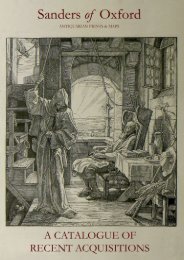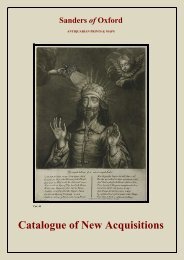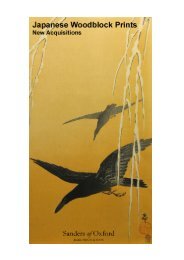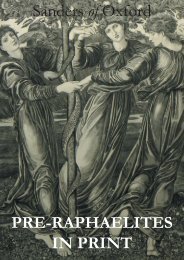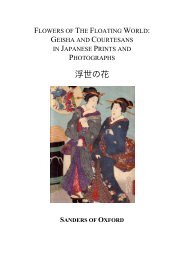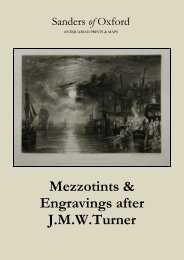Surimono catalogue FINAL WEB.pdf - Sanders of Oxford
Surimono catalogue FINAL WEB.pdf - Sanders of Oxford
Surimono catalogue FINAL WEB.pdf - Sanders of Oxford
Create successful ePaper yourself
Turn your PDF publications into a flip-book with our unique Google optimized e-Paper software.
<strong>Surimono</strong><br />
A <strong>catalogue</strong> <strong>of</strong> privately commissioned original<br />
Japanese woodblock prints from the 19th<br />
century.<br />
<strong>Sanders</strong> <strong>of</strong> <strong>Oxford</strong>, Rare Prints & Maps. Salutation House,104 High Street, <strong>Oxford</strong>, OX1 4BW.<br />
www.sanders<strong>of</strong>oxford.com, info@sanders<strong>of</strong>oxford.com, 01865 242590
<strong>Surimono</strong> is the name given to a type <strong>of</strong> privately published Japanese<br />
woodblock print that became especially popular in the first third <strong>of</strong> the<br />
nineteenth century. Literally meaning “printed object”, surimono can refer<br />
to text, pictures, or frequently, a combination <strong>of</strong> the two. The word was<br />
first recorded as early as 1094 but it wasn’t until the1760s that the term<br />
began to be applied to a new form <strong>of</strong> woodblock print: that which was<br />
privately commissioned and published in limited editions. Experiemental<br />
and elaborately printed, surimono were designed by the leading ukiyoe<br />
artists <strong>of</strong> the day and amateurs alike, <strong>of</strong>ten to commemorate special<br />
occasions such as the New Year, and distributed amongst friends and<br />
associates.<br />
The surimono tradition <strong>of</strong> privately distributed woodblock prints can be<br />
split into two distinctions: publications to announce or commemorate<br />
events such as musical performances or national holidays, and<br />
publications which combined image and verse, <strong>of</strong>ten commissioned<br />
by poetry societies. The images were used to illustrate the seventeen<br />
syllable haiku or the thirty-one syllable kyōka, enriching the verse with<br />
visual context and vice versa. Although trimmed <strong>of</strong>f in some cases, text<br />
also features in announcement surimono, and is one <strong>of</strong> the elements that<br />
sets this tradition apart from commercially published woodblock prints.<br />
The advent <strong>of</strong> surimono in the 18 th century coincided with major<br />
advances in colour printing in Japan and surimomo artists were able to<br />
take full advantage, experimenting with new pigments and techniques.<br />
Artists designing surimono did not operate under the same constraints<br />
as designers <strong>of</strong> commercial prints, and having only the wishes <strong>of</strong><br />
the commissioner to restrict them, these works were <strong>of</strong>ten produced<br />
as deluxe prints with an abundant use <strong>of</strong> gold and silver pigments,<br />
delicate and complicated colour palettes, elaborate embossing and<br />
complicated designs. Printed on hōsho, a thick, <strong>of</strong>ten unsized, paper, the<br />
smaller shikishiban format used for surimomo was particularly suited to<br />
embossing and absorbing pigments. This enabled artists to apply more<br />
complicated techniques than in larger prints where colour had to cover a<br />
larger area or the paper was harder.<br />
Unrestricted by commercial demands, privately published surimono<br />
allowed the artist to explore a wider range <strong>of</strong> subject matter. <strong>Surimono</strong><br />
designers <strong>of</strong>ten pioneered subject matter that found its way into<br />
commercial prints later. For example, such works <strong>of</strong>ten depicted women<br />
engaging in domestic activities associated with the New Year. The “still<br />
life” flourished in surimono design while being neglected in standard
ukiyo-e printmaking. The many surimono <strong>of</strong> birds, animals and flowers<br />
may have encouraged Hiroshige to design commercial prints <strong>of</strong> these<br />
subjects and Hokusai and Hokkei’s designs <strong>of</strong> historical and legendary<br />
figures were a direct inspiration for Kuniyoshi’s popular Suikoden series.<br />
The demand for surimono waned by the 1830s as subject matter that<br />
had not previously been addressed in commercial printing began to<br />
appear in ukiyo-e woodblocks, reducing the need for the works that had<br />
first inspired them. Towards the end <strong>of</strong> the 19 th and into the 20 th century<br />
reproductions <strong>of</strong> early surimono made between 1810 and 1830 were<br />
produced. Principally sold to Western tourists in Japan, these copies have<br />
become known as Akashi surimono after the town in which they were<br />
made. Akashi surimono are extremely fine reproductions incorporating the<br />
same lavish features <strong>of</strong> the originals, such as blind printing and the ornate<br />
use <strong>of</strong> rich pigments. The most tangible difference was merely the rigidity<br />
and colour <strong>of</strong> the paper, the 1820s hōsho being s<strong>of</strong>ter and more porous<br />
than the later paper, which also had the tendency to turn a slight brown<br />
colour due to the sizing used. Akashi suirmono were <strong>of</strong>ten mistaken for<br />
the originals until the 1970s and it was Roger Keyes groundbreaking<br />
research and subsequent essay in his 1985 book The Art <strong>of</strong> <strong>Surimono</strong><br />
that has defined Akashi and their groupings. Keyes found that Akashi<br />
surimono in the square format fall into four categories A, B, C, and D. The<br />
groups are defined by the quality <strong>of</strong> reproduction with A being the highest<br />
quality. Keyes also created a list <strong>of</strong> known Akashi surimono which has<br />
aided in identifying them from the originals.<br />
In this <strong>catalogue</strong> we present a collection <strong>of</strong> original and Akashi surimono.<br />
All but one <strong>of</strong> the Akashi surimono are Meiji A copies. Original surimono<br />
prints are scarce because they were privately published in such limited<br />
numbers. Akashi surimono have become collectible in the own right,<br />
many are rare themselves and <strong>of</strong>ten depict surimono for which there is no<br />
known original. Whilst Akashi surimono were reproduced with the same<br />
techniques as the originals that they copy, they are much less expensive<br />
than the originals, another factor which has fuelled their collectability.
1. Ferry on the Sumida River.<br />
Woodblock with gauffrage<br />
after Keisai Eisen (1790-1848)<br />
early 1890’s<br />
Shikishiban 212 x 187 mm<br />
mounted<br />
Meiji A copy<br />
Signature: Keisai<br />
Refrence: Keyes, Roger. The Art <strong>of</strong> <strong>Surimono</strong>: Privately publised Japanese woodblock prints and<br />
books in the Chester Beatty Library, Dublin. Sotheby, London, 1985. pg. 514, 3.<br />
[27825]<br />
£250
2. Courtesan seated beside a life-size wooden carving <strong>of</strong> a kamuro.<br />
Woodblock with gauffrage<br />
Hosoda Eishi (1756-1829)<br />
early 1890’s<br />
Shikishiban 208 x 180 mm<br />
mounted<br />
Meiji C copy<br />
Refrence: Keyes, Roger. The Art <strong>of</strong> <strong>Surimono</strong>: Privately publised Japanese woodblock prints and<br />
books in the Chester Beatty Library, Dublin. Sotheby, London, 1985. pg. 513, 5.<br />
Condition: Tipped to another piece <strong>of</strong> paper.<br />
[27839]<br />
£120
3. Porcelain cup, tie-dyed silk, and hair ornaments.<br />
Woodblock with gauffrage<br />
after Kikukawa Eishin (active c. 1810s - 1820s)<br />
early 1890’s<br />
Shikishiban 212 x 186 mm<br />
mounted<br />
A calander picture for 1818.<br />
Meiji A copy<br />
Signature: Horai Eishin ga.<br />
Refrence: Keyes, Roger. The Art <strong>of</strong> <strong>Surimono</strong>: Privately publised Japanese woodblock prints and<br />
books in the Chester Beatty Library, Dublin. Sotheby, London, 1985. pg. 514, 6.<br />
The object in the black lacquer box is a tortoiseshell hairpin. The tie-dye silk cloth, the green<br />
embossed white cords, and the silver hairpin are all hair ornaments. The original print was<br />
published as a picture calendar for 1818.<br />
[27724]<br />
£250
4. Old man laughing at two sparrows dressed as women.<br />
Woodblock with gauffrage<br />
after Kikugawa Eizan (1787-1868)<br />
early 1890’s<br />
Shikishiban 207 x 188 mm<br />
mounted<br />
Meiji A copy<br />
Series title: Mukashibanashi chijin’yu: Wisdom, Benevolence, and Bravery in Fairy Tales<br />
Refrence: Keyes, Roger. The Art <strong>of</strong> <strong>Surimono</strong>: Privately publised Japanese woodblock prints and<br />
books in the Chester Beatty Library, Dublin. Sotheby, London, 1985. pg. 514, 7.<br />
[27826]<br />
£300
5. The calligrapher Ono no T<strong>of</strong>u standing beside a writing table.<br />
Woodblock with gauffrage<br />
after Yashima Gakutei (ca.1786 - 1868)<br />
early 1890’s<br />
Shikishiban 208 x 181 mm<br />
mounted<br />
Meiji A copy<br />
Series title: Bumbo shiyu: The Four Friends <strong>of</strong> the Writing Table<br />
Refrence: Keyes, Roger. The Art <strong>of</strong> <strong>Surimono</strong>: Privately publised Japanese woodblock prints and<br />
books in the Chester Beatty Library, Dublin. Sotheby, London, 1985. pg. 514, 8.<br />
Condition: Small hole in the lower right border.<br />
[27827]<br />
£280
6. Chinese princess looking down at box with spider’s web.<br />
Woodblock with gauffrage<br />
after Yashima Gakutei (ca.1786 - 1868)<br />
early 1890’s<br />
Shikishiban 216 x 188 mm<br />
mounted<br />
Meji A copy<br />
Series: Niban tsuzuki: Diptych<br />
Signature: Sadaoka Gakutei hitsu<br />
Publisher: Tsumura Isakichi<br />
Poems by: Shunjoro Mitsune and Katanoue Koreneri<br />
Refrence: Keyes, Roger. The Art <strong>of</strong> <strong>Surimono</strong>: Privately publised Japanese woodblock prints and<br />
books in the Chester Beatty Library, Dublin. Sotheby, London, 1985. pg. 514, 20.<br />
[27637]<br />
£350
7. Geisha strolling with kamuro; entrance gate <strong>of</strong> the Yoshiwara.<br />
Woodblock with gauffrage<br />
after Yashima Gakutei (ca.1786 - 1868)<br />
early 1890’s<br />
Shikishiban 216 x 190 mm<br />
mounted<br />
Meiji A copy<br />
Series title: Honchoren juban: Ten Pictures for the Honcho Circle<br />
Refrence: Keyes, Roger. The Art <strong>of</strong> <strong>Surimono</strong>: Privately publised Japanese woodblock prints and<br />
books in the Chester Beatty Library, Dublin. Sotheby, London, 1985. pg. 514, 11.<br />
[27744]<br />
£300
8. Lady Wei seated at a writing table.<br />
Woodblock with gauffrage<br />
after Yashima Gakutei (ca.1786 - 1868)<br />
early 1890’s<br />
Shikishiban 208 x 184 mm<br />
mounted<br />
Meiji A copy<br />
Series title: Bumbo shiyu: The Four Friends <strong>of</strong> the Writing Table<br />
Refrence: Keyes, Roger. The Art <strong>of</strong> <strong>Surimono</strong>: Privately publised Japanese woodblock prints and<br />
books in the Chester Beatty Library, Dublin. Sotheby, London, 1985. pg. 514, 9.<br />
[27745]<br />
£300
9. Peasant family seated beside a hearth.<br />
Woodblock with gauffrage<br />
after Yashima Gakutei (ca.1786 - 1868)<br />
early 1890’s<br />
Shikishiban 216 x 183 mm<br />
mounted<br />
Meiji A copy<br />
Series title: Honchoren honcho nijushiko: Twenty-four Examples <strong>of</strong> Filial Devotion in Japan for the<br />
Honcho Circle<br />
Refrence: Keyes, Roger. The Art <strong>of</strong> <strong>Surimono</strong>: Privately publised Japanese woodblock prints and<br />
books in the Chester Beatty Library, Dublin. Sotheby, London, 1985. pg. 514, 12.<br />
Condition: Tiny loss lower left.<br />
[27746]<br />
£200
10. The poetess Ono no Komachi standing on a verandah.<br />
Woodblock with gauffrage<br />
after Yashima Gakutei (ca.1786 - 1868)<br />
early 1890’s<br />
Shikishiban 208 x 181 mm<br />
mounted<br />
Meiji A copy<br />
Series title: Katsushika sakura zukushi: Cherry Trees for the Katsuhika<br />
Refrence: Keyes, Roger. The Art <strong>of</strong> <strong>Surimono</strong>: Privately publised Japanese woodblock prints and<br />
books in the Chester Beatty Library, Dublin. Sotheby, London, 1985. pg. 514, 13.<br />
[27747]<br />
£300
11. Two blowfish and branch <strong>of</strong> plum blossom.<br />
Woodblock with gauffrage<br />
after Yashima Gakutei (ca.1786 - 1868)<br />
early 1890’s<br />
Shikishiban 212 x 182 mm<br />
mounted<br />
Meiji A copy<br />
Refrence: Keyes, Roger. The Art <strong>of</strong> <strong>Surimono</strong>: Privately publised Japanese woodblock prints and<br />
books in the Chester Beatty Library, Dublin. Sotheby, London, 1985. pg. 514, 22.<br />
[27723]<br />
£300
12. Wine kettle and cup wrapped in silk gauze.<br />
Woodblock with gauffrage<br />
after Yashima Gakutei (ca.1786 - 1868)<br />
early 1890’s<br />
Shikishiban 215 x 183 mm<br />
mounted<br />
Meiji A copy<br />
Refrence: Keyes, Roger. The Art <strong>of</strong> <strong>Surimono</strong>: Privately publised Japanese woodblock prints and<br />
books in the Chester Beatty Library, Dublin. Sotheby, London, 1985. pg. 514, 27.<br />
[27709]<br />
£220
13. The launderess Kanejo.<br />
Woodblock print with gauffage<br />
Yashima Gakutei (ca.1786 - 1868)<br />
c. 1822<br />
Shikishiban 209 x 184. mm<br />
mounted<br />
Series: Katsushikaren gakumen fujin awase: Framed Paintings <strong>of</strong> Women for the Katsushika<br />
Circle<br />
Signature: Gakutei<br />
Refrence: Keyes, Roger. The Art <strong>of</strong> <strong>Surimono</strong>: Privately publised Japanese woodblock prints and<br />
books in the Chester Beatty Library, Dublin. Sotheby, London, 1985. pg. 94, 56.<br />
Kanejo, or Okane, was a prostitute in Kaizu, a town on the north shore <strong>of</strong> Lake Biwa, and a<br />
strategic point on the road bewtween Kyoto and Tsuruga in Echizen Province.One day while she<br />
was laundering by the lake, a runaway horse approached her. She planted one <strong>of</strong> her woden<br />
sandals on the horse’s reins and held it there firmly until the animal was subdued. The poem is by<br />
Kaentei Shigeki.<br />
Condition: Slightly faded and slightly soiled. Some overall creasing.<br />
[27840]<br />
£650
14. Woman Holding a Tortoise-shaped Paperweight (Bunchin), from the series<br />
Seven Designs for the Katsushika Circle: Katsushika shichiban tsuzuki.<br />
Woodblock print with gauffage<br />
Yashima Gakutei (ca.1786 - 1868)<br />
c. 1826<br />
Shikishiban 210 x 185 mm<br />
mounted<br />
Series: Katsushika shichiban tsuzuki: Seven pictures for the Katsushika Group<br />
Poetry : Bunritsuen Kokin and Bunsaien Fudemaru.<br />
From a seven sheet series which forms a continuous composition linked by the gold screen in<br />
the background. The silver tortoise held in her hand, together with the paintings <strong>of</strong> a tortoise and<br />
crane, were symbols <strong>of</strong> longevity appropriate for surimono intended for the New Year.<br />
Condition: Slightly faded and slightly soiled. Other minor defects.<br />
[27636]<br />
£950
15. Mirror with reflection <strong>of</strong> a nine-tailed fox.<br />
Woodblock with gauffrage<br />
after Harukawa Goshichi (1776-1831)<br />
early 1890’s<br />
Shikishiban 215 x 183 mm<br />
mounted<br />
Meiji A copy<br />
Seals: Harukawa Goshichi, Tani Seiko<br />
Refrence: Keyes, Roger. The Art <strong>of</strong> <strong>Surimono</strong>: Privately publised Japanese woodblock prints and<br />
books in the Chester Beatty Library, Dublin. Sotheby, London, 1985. pg. 514, 29.<br />
[27710]<br />
£220
16. Pheasant seated in a willow tree.<br />
Woodblock with gauffrage<br />
Kikugawa Hidemaro (fl. 1804-1817)<br />
early 1890’s<br />
Shikishiban 208 x 180 mm<br />
mounted<br />
Meiji A copy<br />
Refrence: Keyes, Roger. The Art <strong>of</strong> <strong>Surimono</strong>: Privately publised Japanese woodblock prints and<br />
books in the Chester Beatty Library, Dublin. Sotheby, London, 1985. pg. 514, 33.<br />
[27838]<br />
£90
17. Hanging Scroll with painting <strong>of</strong> immortal and crane.<br />
Woodblock with gauffrage<br />
after Utagawa Hiroshige (1797-1858)<br />
early 1890’s<br />
Shikishiban 211 x 186 mm<br />
mounted<br />
Meiji A copy, box embossed<br />
Refrence: Keyes, Roger. The Art <strong>of</strong> <strong>Surimono</strong>: Privately publised Japanese woodblock prints and<br />
books in the Chester Beatty Library, Dublin. Sotheby, London, 1985. pg. 514, 34.<br />
[27828]<br />
£150
18. Pottery doll <strong>of</strong> kneeling woman, fern, and New Year ornament.<br />
Woodblock with gauffrage<br />
after Totoya Hokkei (1780-1850)<br />
early 1890’s<br />
Shikishiban 209 x 185 mm<br />
mounted<br />
Meiji A copy<br />
Refrence: Keyes, Roger. The Art <strong>of</strong> <strong>Surimono</strong>: Privately publised Japanese woodblock prints and<br />
books in the Chester Beatty Library, Dublin. Sotheby, London, 1985. pg. 514, 81.<br />
[27721]<br />
£200
19. Two fans against a pattern <strong>of</strong> running water.<br />
Woodblock with gauffrage<br />
after Totoya Hokkei (1780-1850)<br />
early 1890’s<br />
Shikishiban 206 x 183 mm<br />
mounted<br />
Meiji A copy<br />
Series Title: Goshiki bantsuzuki ogi nagashi: Five Colours on Floating Fans<br />
Refrence: Keyes, Roger. The Art <strong>of</strong> <strong>Surimono</strong>: Privately publised Japanese woodblock prints and<br />
books in the Chester Beatty Library, Dublin. Sotheby, London, 1985. pg. 514, 83.<br />
[27722]<br />
£200
20. Woman painting a pictue <strong>of</strong> Mt. Fuji.<br />
Woodblock with gauffrage<br />
after Teisai Hokuba (1771-1844)<br />
early 1890’s<br />
Shikishiban 213 x 185 mm<br />
mounted<br />
Meiji A copy<br />
Series title: Makura soshi: The Pillow Book<br />
Signature: Teisai<br />
Refrence: Keyes, Roger. The Art <strong>of</strong> <strong>Surimono</strong>: Privately publised Japanese woodblock prints and<br />
books in the Chester Beatty Library, Dublin. Sotheby, London, 1985. pg. 514, 85.<br />
[27643]<br />
£350
21. Armour and arrow.<br />
Woodblock with gauffrage<br />
after Katsushika Hokusai (1760-1849)<br />
early 1890’s<br />
Shikishiban 212 x 188 mm<br />
mounted<br />
Meiji A copy<br />
Series title: Shisei: The Four Clans<br />
Signature: Fusenkyo Iitsu Hitsu<br />
Refrence: Keyes, Roger. The Art <strong>of</strong> <strong>Surimono</strong>: Privately publised Japanese woodblock prints and<br />
books in the Chester Beatty Library, Dublin. Sotheby, London, 1985. pg. 514, 88.<br />
Condition: Worm hole in image.<br />
[27638]<br />
£280
22. Crow with sword.<br />
Woodblock with gauffrage<br />
after Katsushika Hokusai (1760-1849)<br />
early 1890’s<br />
Shikishiban 214 x 188 mm<br />
mounted<br />
Meiji A copy<br />
Series title: Shisei: The Four Clans<br />
Signature: Fusenkyo Iitsu hitsu<br />
Refrence: Keyes, Roger. The Art <strong>of</strong> <strong>Surimono</strong>: Privately publised Japanese woodblock prints and<br />
books in the Chester Beatty Library, Dublin. Sotheby, London, 1985. pg. 514, 91.<br />
[27646]<br />
£220
23. Flute, lute in bocade case and cherry blossoms.<br />
Woodblock with gauffrage<br />
after Katsushika Hokusai (1760-1849)<br />
early 1890’s<br />
Shikishiban 214 x 188 mm<br />
mounted<br />
Meiji A copy<br />
Series title: Shisei: The Four Clans<br />
Signature: Fusenkyo Iitsu hitsu<br />
Refrence: Keyes, Roger. The Art <strong>of</strong> <strong>Surimono</strong>: Privately publised Japanese woodblock prints and<br />
books in the Chester Beatty Library, Dublin. Sotheby, London, 1985. pg. 514, 90.<br />
[27647]<br />
£180
24. Jewels and sickle on stand.<br />
Woodblock with gauffrage<br />
after Katsushika Hokusai (1760-1849)<br />
early 1890’s<br />
Shikishiban 216 x 186 mm<br />
mounted<br />
Meiji A copy<br />
Series title: Shisei: The Four Clans<br />
Signature: Fusenkyo Iitsu hitsu<br />
Refrence: Keyes, Roger. The Art <strong>of</strong> <strong>Surimono</strong>: Privately publised Japanese woodblock prints and<br />
books in the Chester Beatty Library, Dublin. Sotheby, London, 1985. pg. 514, 91.<br />
[27645]<br />
£180
25. Tobacco pouch, pipe case, and wooden box.<br />
Woodblock with gauffrage<br />
after Katsushika Hokusai (1760-1849)<br />
early 1890’s<br />
Shikishiban 213 x 185 mm<br />
mounted<br />
Meiji A copy<br />
Series title: Uma tsukushi: Horses<br />
Refrence: Keyes, Roger. The Art <strong>of</strong> <strong>Surimono</strong>: Privately publised Japanese woodblock prints and<br />
books in the Chester Beatty Library, Dublin. Sotheby, London, 1985. pg. 514, 92.<br />
[27644]<br />
£180
26. Vases, trays, and materials for flower arrangement; the Flower Shell.<br />
Woodblock with gauffrage<br />
after Katsushika Hokusai (1760-1849)<br />
early 1890’s<br />
Shikishiban 207 x 180 mm<br />
mounted<br />
Meiji A copy<br />
Series title: Genroku kasen kai awase: A Matching Game with the Genroku Poem Shells<br />
Refrence: Keyes, Roger. The Art <strong>of</strong> <strong>Surimono</strong>: Privately publised Japanese woodblock prints and<br />
books in the Chester Beatty Library, Dublin. Sotheby, London, 1985. pg. 514, 86.<br />
[27694]<br />
£170
27. Oi pouring wine from a cask for Hankai.<br />
Woodblock with gauffrage<br />
after Katsushika Hokusai (1760-1849)<br />
early 1890’s<br />
Shikishiban 217 x 190 mm<br />
mounted<br />
Meiji A copy<br />
Series title: Soramitsuya-ren wakan buyu- awase: Sanban no uchi A Comparison <strong>of</strong> Valour in<br />
China and Japan<br />
Refrence: Keyes, Roger. The Art <strong>of</strong> <strong>Surimono</strong>: Privately publised Japanese woodblock prints and<br />
books in the Chester Beatty Library, Dublin. Sotheby, London, 1985. pg. 514, 87.<br />
[27708]<br />
£350
28. Woman preparing a tray landscape.<br />
Woodblock with gauffrage<br />
after Katsushika Hokusai (1760-1849)<br />
early 1890’s<br />
Shikishiban 211 x 184 mm<br />
mounted<br />
Meiji A copy<br />
Series title: Osana asobi ken: Three Pictures for A Children’s Handgame<br />
Signature: Hokusai aratame Iitsu Hitsu<br />
Refrence: Keyes, Roger. The Art <strong>of</strong> <strong>Surimono</strong>: Privately publised Japanese woodblock prints and<br />
books in the Chester Beatty Library, Dublin. Sotheby, London, 1985. pg. 514, 94.<br />
Condition: Two worm holes.<br />
[27692]<br />
£270
29. Woman with kite caught in bundle <strong>of</strong> twigs.<br />
Woodblock with gauffrage<br />
after Katsushika Hokusai (1760-1849)<br />
early 1890’s<br />
Shikishiban 209 x 188 mm<br />
mounted<br />
Meiji A copy<br />
Signature: Saki no Sori Hokusai ga<br />
Refrence: Keyes, Roger. The Art <strong>of</strong> <strong>Surimono</strong>: Privately publised Japanese woodblock prints and<br />
books in the Chester Beatty Library, Dublin. Sotheby, London, 1985. pg. 514, 95.<br />
Condition: Two worm holes.<br />
[27693]<br />
£250
30. Courtesan and samurai.<br />
Woodblock print with gauffage<br />
Aoigaoka Keisei (fl. 1818-1844)<br />
c. 1830-35<br />
Shikishiban 207 x 178 mm<br />
mounted<br />
Signature: Aoigaoka Keisei<br />
With a kyoka poem by Kajitsuen Hidenari enclosed within a circle to the top right corner.<br />
[27841]<br />
£1,400
31. Ichikawa Danjuro VII as the blind hero Kagekiyo and Segawa Kikunojo V .<br />
Woodblock print<br />
attributed to Utagawa Kunisada (1786-1865)<br />
c. 1825<br />
Shikishiban 180 x 257 mm<br />
mounted<br />
Unidentified collector’s mark on verso<br />
Conditon: Several worm holes.<br />
[27844]<br />
£650
32. Mimasu Gennosuke.<br />
Woodblock print<br />
Utagawa Kunisada (1786-1865)<br />
c.1830<br />
Shikishiban 190 x 170 mm<br />
mounted<br />
Signature: Kunisada<br />
Kabuki actor Mimasu Gennosuke. He is wearing a kimono with wisteria pattern. This print comes<br />
from a very rare and sought after series by Kunisada <strong>of</strong> Okuni-e actor portraits published in<br />
Kakuban size.<br />
[27846]<br />
£375
33. Woman Dancing Sanbasô.<br />
Woodblock with gauffrage<br />
Utagawa Kunisada (1786-1865)<br />
1830<br />
191 x 127 mm<br />
mounted<br />
Signature: Gototei Kunisada ga<br />
Publisher: Shimizu-ya<br />
Censor: kiwame<br />
Unidentified collectors’ marks on verso.<br />
[27836]<br />
£650
34. Untitled<br />
Woodblock with gauffrage<br />
Kunimitsu Utagawa (active ca. 1800-1820)<br />
c. 1810<br />
Shikishiban 192 x 177 mm<br />
mounted<br />
Signature: Ichiyosai Kunimitsu ga<br />
Kunimitsu Utagawa was a pupil <strong>of</strong> Toyokuni. He was a prolific book illustrator, but his prints are<br />
rare.<br />
[27851]<br />
£700
35. Still life with vase <strong>of</strong> blossoms next to a crab.<br />
Woodblock print<br />
Unread<br />
c. 1820<br />
204 x 165 mm<br />
mounted<br />
[27843]<br />
£900
36. [Man on a Dragon].<br />
Woodblock with gauffrage<br />
Unread<br />
c. 1810<br />
Shikishiban 212 x 183 mm<br />
Mounted<br />
[27852]<br />
£1,000
Artist Biographies
Keisai Eisen (1790-1848)<br />
Keisai Eisen was the son <strong>of</strong> the colligrapher Ikeda Shigeharu. He was born in Edo and studied<br />
with a Kano painter, Hakkeisai, and then with Kikugawa Eizan. He specialised in pictures <strong>of</strong><br />
women, book illustrations and erotica. He designed a number <strong>of</strong> surimono in the late 1810s<br />
andlate 1820s.<br />
Hosoda Eishi (1756-1829)<br />
Hosoda Eishi was a samurai who studied with Kano Eisen in Sukenobu and became an <strong>of</strong>ficial<br />
painter at the court <strong>of</strong> the shogun in Edo. He was given the name Eishi, it the alleged, by the<br />
Tokugawa shogun Ieharu. In the mid 1780s he was supposed to have studied with an otherwise<br />
unknown ukiyo-e printmaker named Torii Bunryusai. Eishi designed his first woodblock prints<br />
around 1786. During the next decade he was very active as print designer, specializing in pictures<br />
<strong>of</strong> beautiful women. Around 1797 he retired from print design and devoted the rest <strong>of</strong> his life to<br />
painting.<br />
Kikukawa Eishin (fl. c. 1810s - 1820s)<br />
Kikukawa Eishin was a pupil <strong>of</strong> Kikukawa Eizan. He designed a few commerical and surimono<br />
prints.<br />
Kikugawa Eizan (1787-1868)<br />
Eizan was the most prolific, longest-lived and ultimately the best <strong>of</strong> the late followers <strong>of</strong> Utamaro,<br />
who attempted to carry on the master’s bijin style after his death in 1806. Along with Kikumaro,<br />
Tsukimaro and Utamaro II, Eizan has generally been dismissed by connoisseurs as a plagiarist<br />
<strong>of</strong> Utamaro’s late style, but his work developed, like that <strong>of</strong> most ukiyo-e artists, from a close<br />
identification with a leading master to a studied independence.Unlike the artists with whom he<br />
is <strong>of</strong>ten associated, Eizan was not an actual pupil <strong>of</strong> Kitagawa Utamaro, but studied originally<br />
with his father, Kikugawa Eiji, a Kano style painter and fan maker, and later with the Shijo artist<br />
Suzuki Nanrei and the Hokusai pupil Hokkei. He produced some remarkable triptychs and vertical<br />
diptychs, as well as a few surimono. He seems to have retired from printmaking in the late 1820s,<br />
though he did contribute illustrations for books even quite late in his life.<br />
Yashima Gakutei (c. 1786 - 1868)<br />
Schooled in Kokusai’s workshop under the tutelage <strong>of</strong> Hokkei, Gakutei, while principally involved<br />
in creating surimono, was a well known writer and kyôka poet. He was the illegitimate son <strong>of</strong><br />
an Edo samurai by the name <strong>of</strong> Hirata, who was in the service <strong>of</strong> the Bakufu. His mother’s<br />
subsequent marriage into the Yashima clan, however, gave him the art-name by which he is<br />
chiefly known. Although prolific, it was the delicate beauty and precise technical quality <strong>of</strong> his<br />
surimono, which distinguished him from other artists.<br />
Harukawa Goshichi (1776-1831)
Harukawa Goshichi was born in Edo and in 1818 he moved to Kyoto. At the beginnning <strong>of</strong> his<br />
career he drew and published portraits <strong>of</strong> actors as well as surimono. Goshichi also wrote and<br />
illustrated his own novels. He was possibly a pupil <strong>of</strong> Harukawa Eizan, from whom he took his<br />
name.<br />
Kikugawa Hidemaro (fl. 1804-1817)<br />
Hidemaro Kitagawa was a pupil <strong>of</strong> Utamaro. During Utamaro’s last years he was active in<br />
assisting his master in book illustrations.<br />
Utagawa Hiroshige (1797-1858)<br />
Utagawa Hiroshige was born in Edo, the son <strong>of</strong> a supervisor <strong>of</strong> a brigade <strong>of</strong> firemen. He studied<br />
painting with a neighbour, Okajima Rinsai, and 1811, at the age <strong>of</strong> fourteen, he began to study with<br />
the ukiyo-e artist Toyohiro. In 1814 his first print was published, but it was not unitl 1818 that he<br />
produced prints in any number. In about 1821, he produced his first square surimono and during<br />
the next decade he designed over two dozen more – a small number compared to the many<br />
thousands <strong>of</strong> commerical prints.<br />
Totoya Hokkei (1780-1850)<br />
One <strong>of</strong> Hokusai’s earliest and most gifted pupils, Hokkei was particularly renowned in the field <strong>of</strong><br />
surimono. Before his initial training with Kanô Yôsen’ in Korenobu, he worked as a fishmonger<br />
at Yotsuya Samegahashi, hence the unusual art surname <strong>of</strong> Totoya/Uoya (fish shop). Hokkei’s<br />
first work appeared in 1799. He designed a number <strong>of</strong> surimono in the 1800s and 1810s, but he<br />
did not master the art <strong>of</strong> desiging them until the late 1810s. Besides surimono and illustrations<br />
for poetry albums, Hokkei designed a few illustrations for popular fiction and some commercially<br />
published prints.<br />
Teisai Hokuba (1771-1844)<br />
Teisai Hokuba was an inactive retainer <strong>of</strong> the shogun: later in his life he too lay religious orders.<br />
He was active in the 1800s and 1810 as an illustrator <strong>of</strong> popular fiction, but also designed a<br />
few surimono during this period and continued to design illustrations for privately printed poetry<br />
anthologies thereafter. He may have been one <strong>of</strong> Hokusai’s earliest pupiles and adopted the<br />
name Hokuba while Hokusai was still using the name Sori.<br />
Katsushika Hokusai (1760-1849)<br />
Hokusai began his career as a print designer in 1779 as a pupil <strong>of</strong> Katsukawa Shunso. Hokusai<br />
appears to have become intrigued by the surimono in the 1790s. Fumiko Togasaki, in her 1979<br />
essay on Hokusai’s surimono, suggests that this was related to the Kansei Reforms <strong>of</strong> 1790, which<br />
attempted to control morals and manners as well as publications, including woodblock prints. Each<br />
print was required to have the <strong>of</strong>ficial approval <strong>of</strong> the Tokugawa government, and from this year<br />
on a censor mark appeared on every print. <strong>Surimono</strong> needed neither publisher nor government<br />
approval, because it was privately printed at the patron’s own expense.<br />
In 1796, Hokusai designed a number <strong>of</strong> surimono and privately published album sheets. From<br />
1799 to 1809, he produced a large number <strong>of</strong> surimono prints, but relatively few in the following<br />
decade. In 1820 Hokusai resumed designing surimono and produced a large number in the two
following years. After 1824, Hokusai practically withdrew making surimono although he did make<br />
a few in the early 1830s.<br />
Aoigaoka Keisei (fl. 1818-1844)<br />
Utagawa Kunisada (1786-1865)<br />
Utagawa Kunisada was born in the Homjo district <strong>of</strong> Edo. He became a pupil <strong>of</strong> Toyokuni at the<br />
age <strong>of</strong> fifteen in 1801, and began to design book illustrations and single sheet prints around 1807.<br />
He was recognized as a serious artist after he designed a group <strong>of</strong> seven half-lenghth portraits <strong>of</strong><br />
actors with mica bacgrounds. After he produced these prints he became friends with many <strong>of</strong> the<br />
leading actors, writers, and artists <strong>of</strong> the period. It was probably through his personal contacts<br />
with such people that brought Kunisada so many commissions to design surimono <strong>of</strong> actors for<br />
poets and groups that shared his interest in kabuki theater. Many <strong>of</strong> Kunisada’s surimono are <strong>of</strong><br />
his friend the Kabuki actor Ichikawa Danjuro VII (1791-1859).<br />
Kunisada also designed many surimono <strong>of</strong> beautiful women. His surimono were mainly square<br />
format and range in date from 1810 to 1830, although a majority <strong>of</strong> them were produced between<br />
the late 1810s and late 1820s. He probably designed between 200 and 300 surimono.<br />
Kunimitsu Utagawa (active c. 1800-1820)<br />
Kunimitsu Utagawa was a pupil <strong>of</strong> Toyokuni. He was a prolific book illustrator, but his prints are<br />
rare.<br />
<strong>Sanders</strong> <strong>of</strong> <strong>Oxford</strong>, Rare Prints & Maps.<br />
Salutation House,104 High Street, <strong>Oxford</strong>, OX1 4BW.<br />
www.sanders<strong>of</strong>oxford.com<br />
info@sanders<strong>of</strong>oxford.com<br />
01865 242590




